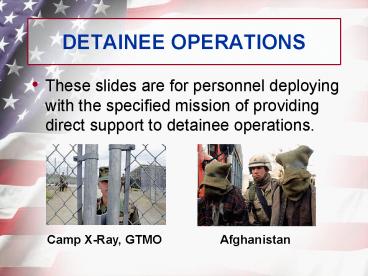DETAINEE OPERATIONS - PowerPoint PPT Presentation
1 / 8
Title:
DETAINEE OPERATIONS
Description:
Security or other personnel in direct contact with detainees are at higher ... don't have any standard personal protective equipment handy, you can improvise. ... – PowerPoint PPT presentation
Number of Views:8152
Avg rating:3.0/5.0
Title: DETAINEE OPERATIONS
1
DETAINEE OPERATIONS
- These slides are for personnel deploying with the
specified mission of providing direct support to
detainee operations.
Camp X-Ray, GTMO
Afghanistan
2
DETAINEE OPERATIONS
- Security or other personnel in direct contact
with detainees are at higher exposure risk for - Bloodborne Pathogens (Hepatitis B and HIV)
- Respiratory Diseases (tuberculosis)
- Additional packing items for personnel deploying
for the specified mission of detainee operations - N95 Respirator
- Fluid proof gloves (Latex or equivalent,
non-sterile)
3
UNIVERSAL PRECAUTIONS
- Universal Precautions or Standard Precautions"
are the terms used to describe a prevention
strategy in which all blood, potentially
infectious materials, and respiratory secretions
are treated as if they are, in fact, infectious,
regardless of the perceived status of the source
individual. - In other wordsWhether or not you think the
blood/body fluid is infected with bloodborne
pathogens, you treat it as if it is.
4
BLOODBORNE PATHOGENS
- Bloodborne pathogens (BBPs) pose a risk to
unprotected personnel when exposed to human blood
and other potentially infectious materials - Body fluids
- Tissues
- Blood-saturated, dripping, or blood-caked
clothing or equipment. - BBPs Include
- Hepatitis B, C, D virus
- Human immunodeficiency virus (HIV)
- 23 other infectious diseases
5
PREVENTION OF BLOODBORNE INFECTION
- Personal Protective Equipment (PPE)
- Gloves (Fluid-Proof)
- Eyes and Face Protection
- Body Protection
- Head and Foot Protection
If you find yourself in a situation where you
have to come in contact with blood or other body
fluids and you don't have any standard personal
protective equipment handy, you can improvise.
Use a towel, plastic bag, or some other barrier
to help avoid direct contact.
6
BLOODBORNE INFECTIONPPE
- Rules to follow
- Always wear personal protective equipment in
exposure situations - Remove PPE that is torn or punctured, or has
lost its ability to function as a barrier to
bloodborne pathogens - Replace PPE that is torn or punctured
- Remove PPE before leaving the work area
To protect yourself, it is essential to have a
barrier between you and the potentially
infectious material
7
BLOODBORNE INFECTION HYGIENE PRACTICES
- Hands or other exposed skin shouldbe thoroughly
washed as soon aspossible following an exposure
incident - Hands should also be washed immediately (or as
soon as feasible) after removal of gloves or
other PPE - If you are working in an area without an approved
water source, you may use an antiseptic cleanser
in conjunction with clean cloth/paper towels or
antiseptic towelettes
8
TUBERCULOSIS(DETAINEE TRANSPORTATION)
- Many of the detainees you are transporting may
have active tuberculosis (TB) - TB transmission may occur during transport
flights - COUNTERMEASURES
- Wear N95 respirator
- Wear your gloves for BBPs
- Receive Universal Precautionstraining prior to
flight - Reduce proximity and duration ofexposure to
detainees (mission first) - TB test 30-days after completionof your last
transport mission

